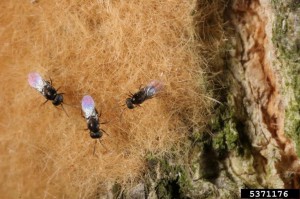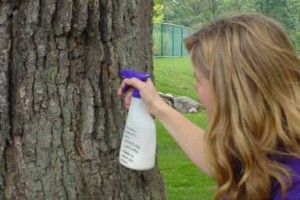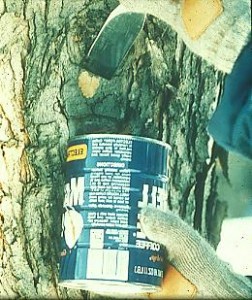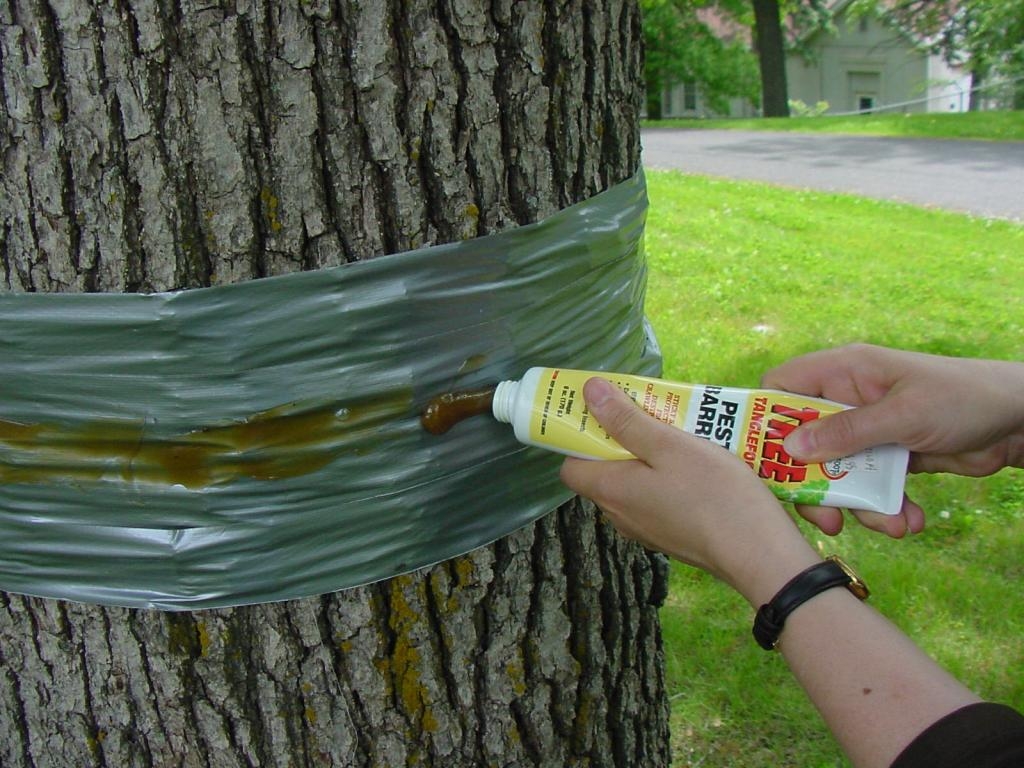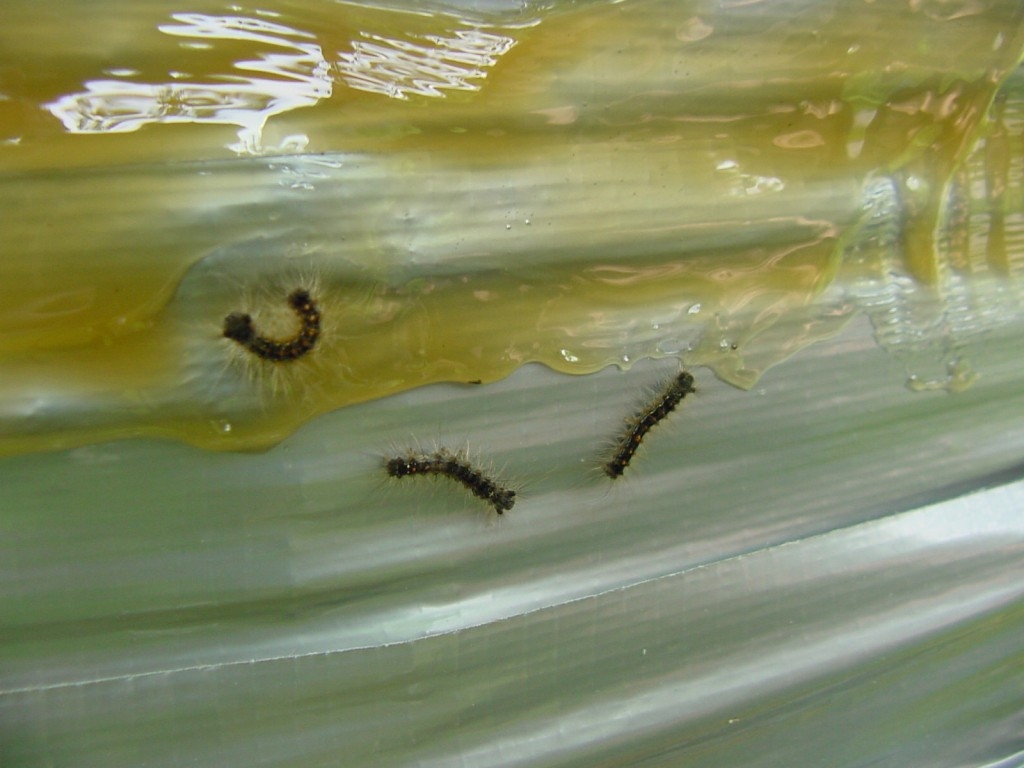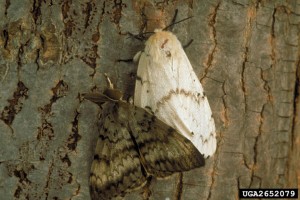Management of the spongy moth varies over the course of the year to target the life stage(s) present. While some management approaches are appropriate for individual yard trees, other approaches are reserved for trained arborists and/or governmental programs (e.g., aerial spraying, mating disruption). This page breaks down management options for homeowners over the course of the year.
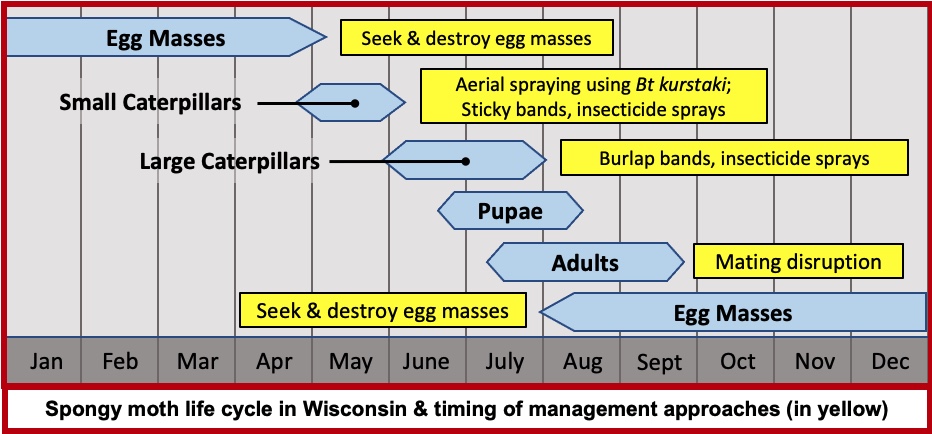
AUGUST—SEPTEMBER: Watch for pinholes in egg masses.
Pinholes indicate the presence of the tiny parasitic wasp Ooencyrtus kuvanae. These wasps do not sting humans but will attack spongy moth (Lymantria dispar) eggs as long as the weather is above freezing.
Photo Credit: Gyorgy Csoka. Hungary Forest Research Institute. 5371176. ForestryImages.org.
MID-OCTOBER—MID-APRIL: Destroy egg masses.
Destroy egg masses by spraying them with a horticultural oil labeled for spongy moth (Lymantria dispar) egg masses (available at lawn and garden centers or online) or by scraping them off and killing them. Do not use motor oil, mineral oils, non-horticultural oils or others not labeled for spongy moth. Spray the oil onto the egg mass until it is soaked. If you scrape off egg masses, be very careful not to harm the bark of the tree. You could do more damage than good that way. Use a knife or paint scraper to gently scrape all of the eggs into a jar. Eggs can be killed by soaking them in soapy water for 2 days before discarding them in the trash. Don’t just scrape egg masses onto the ground or try to crush them with your shoe as many eggs may survive to hatch next spring! Any parts of the egg mass you are unable to scrape off can also hold surviving eggs.
Since egg masses often contain 600+ eggs, every egg mass destroyed can help reduce next year’s caterpillar population.
Photo Credits: Bill McNee WI DNR; Cliff Sadoff Purdue University.
LATE APRIL: Place barrier bands on tree trunks.
Just after spongy moth (Lymantria dispar) eggs have hatched and caterpillars are small, barrier bands can prevent them from climbing back into trees after ballooning or when they have fallen. Barrier bands can be made using duct tape or other nonporous material that can be wrapped around a tree trunk and coated with a commercially available sticky material such as TangleFoot® or Vaseline®. NEVER put sticky material directly on the tree trunk. On thin-barked trees, tie butcher paper or paper bags around the trunk before using the duct tape. The sticky material may need to be re-applied periodically due to rain and other environmental conditions as well as when the bands are covered with caterpillars.
See this page for full instructions for making sticky barrier band traps.
Photo Credits: Mark Guthmiller, WI DNR.
MAY–JUNE: Apply insecticides.
If you choose to use pesticides to control spongy moth (Lymantria dispar) caterpillars, they must be applied at this time to target the caterpillar stages. There are two options: biological and chemical pesticides.
Biological Pesticides: The most common treatment used against spongy moth caterpillars is a spray of Bacillus thuringiensis, commonly called Bt. This biological pesticide is highly specific, meaning different varieties of Bt only affect specific insects. Bacillus thuringiensis kurstaki (Btk) is the specific strain available to control spongy moth caterpillars. This bacterial insecticide kills caterpillars that eat it within a week of its application by damaging the insect’s digestive tract. Bt is found naturally in soil and degrades within a week when exposed to sunlight. The variety of Bt used against spongy moth only affects caterpillars of moths and butterflies that feed on treated leaves. Bt has no affect on other animals, birds, people, or even other insects. It is sold under various labels (e.g., Dipel, Foray, and Thuricide). Bt must be applied to trees in May when caterpillars are less than 1/2-inch long. Timing is critical as Bt is significantly less effective on older/larger caterpillars. Some Btk products are available to the public at hardware stores and garden centers.
Chemical insecticides. Numerous conventional insecticides are labelled for control of spongy moth caterpillars in Wisconsin. Some of these products are intended for use by tree care professionals, while other products may be available at your local garden center or hardware store. Check the label to make sure spongy moths (formerly known as “gypsy moths”) are listed on the label.
Foliar Sprays: A common approach is to spray foliage to prevent feeding damage by spongy moth caterpillars. Common insecticide ingredients labelled for spongy moth include bifenthrin, carbaryl, cyfluthrin, cyhalothrin, cypermethrin, deltamethrin, permethrin, and others. These ingredients typically protect treated foliage for a week or two and multiple applications may be needed to maximize protection against spongy moth caterpillars. Thorough spray coverage is also needed as untreated foliage will not be protected. Foliar treatments are most effective against small caterpillars and may struggle against large caterpillars. While homeowners may be able to spray small trees (e.g., < 10-15 feet tall), larger trees will generally need to be treated by an arborist to achieve good spray coverage.
Organic and reduced-impact sprays: Like Btk, certain foliar spray products can pose fewer risks to other insects. This group includes insecticidal soaps, horticultural oils, pyrethrins, and spinosad. The soaps, oils, and pyrethrins only kill when sprayed directly onto spongy moth caterpillars and are very short-lived. While they can be a good option small plants (e.g., small trees or shrubs), these ingredients are not a good option for larger trees.
Systemic Treatments: While foliar treatments must be sprayed directly onto foliage, some products can move systemically within plants after being applied to the soil or the lower trunk. A few systemic ingredients are labelled for spongy moth, such as acephate, clothianidin, dinotefuran, and emamectin benzoate. While a few systemic products are available to homeowners, many products in this group are for use by tree care professionals and may require specialized training and/or equipment to apply.
The products in this group have notable caveats: 1) systemic products can pose concerns for bees and other pollinators, 2) some systemic ingredients have slow uptake (several weeks) 3) large trees can require large doses of the insecticidal ingredient and homeowners may not be able to legally apply a sufficient dose to fully protect large trees 4) many systemic products have limits on the amount that can be applied to a given area (acre) per year, so systemic products are generally not appropriate for large ares and/or large numbers of trees 5) due to the costs, systemic products can be a consideration for small numbers of high value trees but are not feasible for large numbers of trees.
Considerations for DIY and Professional Options: Many factors influence the feasibility of managing spongy moth with insecticides, such as tree size, number of trees affected (or at risk), size of the area affected, time available to implement management approaches, cost, and life stage of the insect. Consider consulting a certified arborist about your particular situation. In addition, insecticides can be used in combination with other non-chemical management approaches such as destroying egg masses, sticky barrier bands, and burlap barrier bands.
If you elect to use a chemical insecticide, consider the potential impact on beneficial insects and natural enemies such as predators, parasites, and pollinators. ALWAYS read and precisely follow all label directions.
EARLY JUNE: Replace barrier bands with collection bands.
Collection bands can be made from medium-weight, neutral-colored cloth or burlap approximately 12–18 inches wide and long enough to completely wrap around a tree. Using a piece of cord or twine, fasten the middle of the cloth band to the trunk at chest height. Fold the top half of the cloth down to cover the bottom half. Older caterpillars are attracted to these “skirts” when looking for a place to hide during the day. Check for caterpillars daily in mid or late afternoon and scrape them into a container of soapy water.
NOTE: Spongy moth caterpillars are covered with fine “hairs” (setae) that can cause both skin and respiratory irritation. Avoid touching caterpillars bare-handed. Setae can remain in clothing, so clothes that have contacted spongy moths should be washed separately. If skin irritation occurs, consult a physician for advice on topical medications to relieve irritation.

Photo Credits: Mark Guthmiller & Bill McNee, WI DNR.
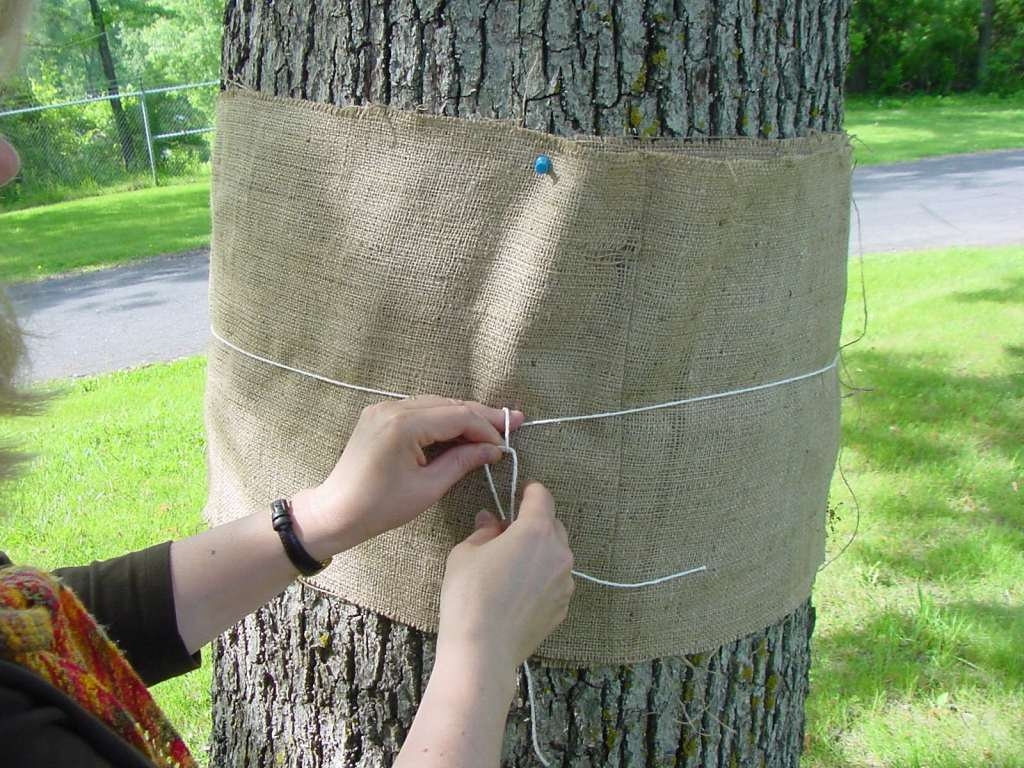
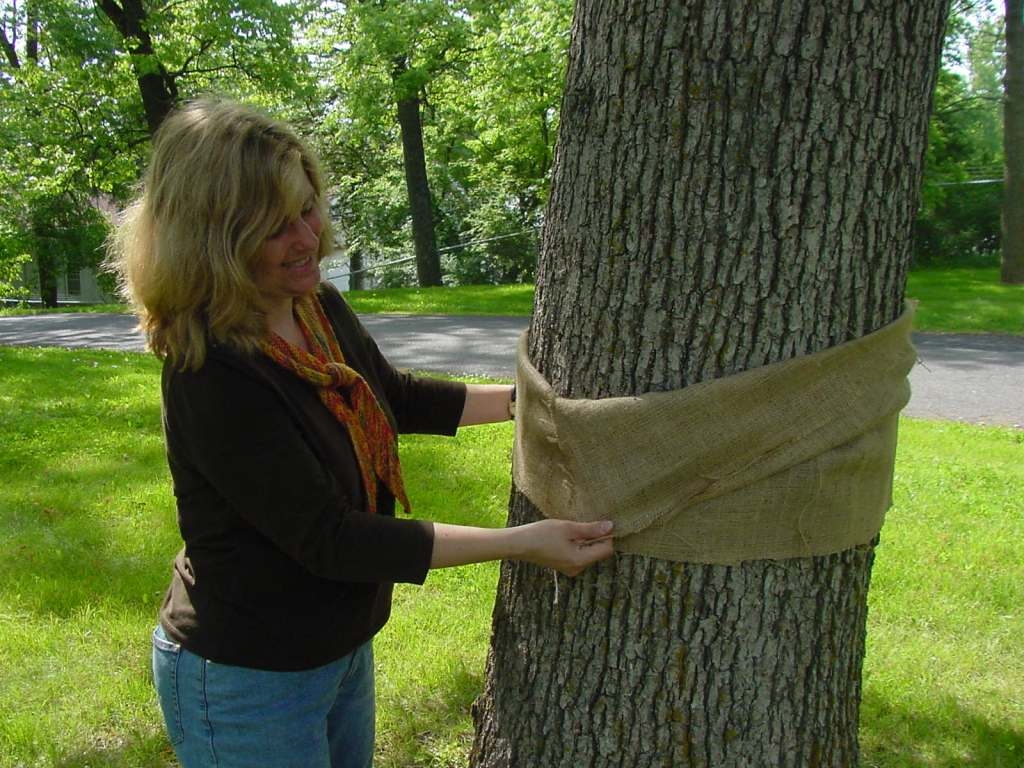

JULY: “Crush & brush” pupae and adult females
Spongy moth (Lymantria dispar) is immobile during its pupal stage and can be crushed or brushed into a container of soapy water to prevent them from making it to the adult stage. If caterpillars have been abundant in your area, do some thorough scouting to check for the brownish pupae (3/4 – 2 1/2 inches long), which are often tucked away in protected spots.
Adult spongy moths appear within two weeks. Adult females (pale colored) have limited mobility and can also be crushed or brushed into a container in soapy water. Since each female can easily lay upwards of 1,000 eggs, eliminating adult female moths could help prevent future problems!
Note: Adult female spongy moths possess a long-lasting chemical pheromone that strongly attracts male spongy moths. Getting this pheromone on your skin, clothing, or objects such as gardening tools can make contaminated surfaces attractive to male moths. Using a disposable item (stick, etc.) to crush adult females can be helpful in this regard.
